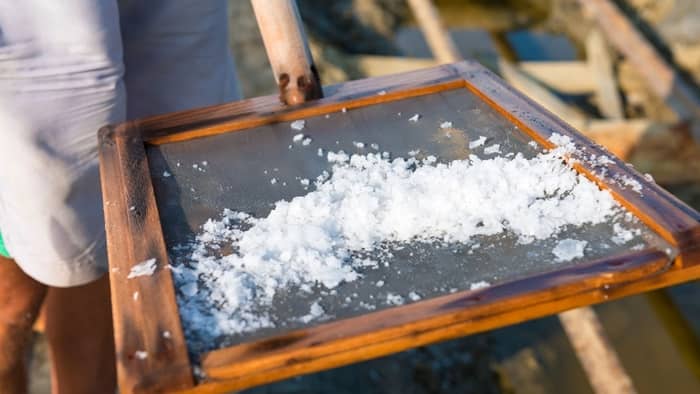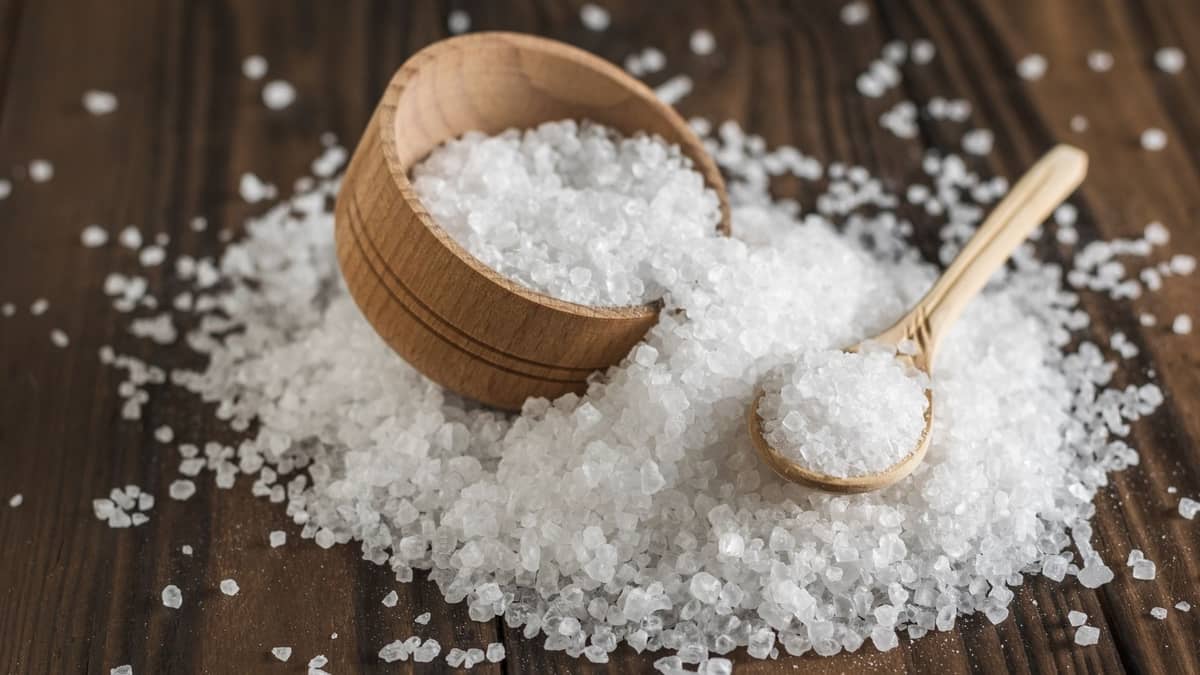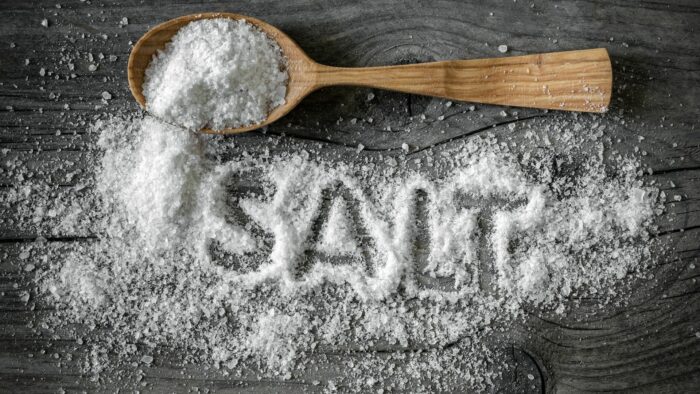Last Updated on February 17, 2023
Salt is one of the most important kitchen ingredients that everyone has at home. It is a staple in both cooking and baking as it enhances the flavor. You may wonder, how much does a cup of salt weigh?
Salt comes in many different types and is readily available and typically affordable. You can buy it in small shakers or larger containers, which are a great option as they are budget-friendly. In addition, salt has a long shelf life so you don’t have to worry about it expiring anytime soon.
How Much Does 1 Cup of Salt Weigh?
Weighing salt allows you to get precise measurements. If using a kitchen scale, 1 cup of salt weighs 273 grams or about 9.62 ounces. The exact weight will vary based on the type of salt you are using, however, table salt is the most common type.
One teaspoon will weigh 5.9 grams and one tablespoon will weigh 17.06 grams. Most of the time when cooking or baking, you will measure salt by teaspoons. However, it is always helpful to know the amount in grams as well.
Measuring out your salt can be helpful when you are storing it. It allows you to know how much salt you have in the container and allows you to keep track of how much you use.
How to Properly Store Salt
Though salt can last a long time, it is important to properly store it to keep it fresh. Pure salt with no additives will never go bad. However, if your salt gets moisture, it will form clumps and affect the flavor of the dish you are making.
It is best to store salt in an airtight container in a cool, dry area. In addition to absorbing water, it can also absorb odors, so this is why it is a good idea to keep it in an airtight container. It is best to keep your salt in glass or porcelain containers for the best storage.
It is best not to keep salt in cardboard containers, as it is easier for moisture and odors to get in. In addition, you typically want to avoid using plastic as well as over time chemicals from it can leak into your salt. You also want to avoid using metal containers as it may cause the metal to rust, contaminating the salt.
Types of Salt
There are many different types of salt available on the market for cooking and baking. Though some types can be used interchangeably, other types have specific purposes. Here are some of the most common types of salt you can buy.
1. Table
Table salt is the most common type of salt and can be used for baking and cooking. It is the type that you will see at restaurants in shakers. It is harvested from salt deposits that are underground.
Table salt is highly refined and ground into a fine consistency, with trace minerals removed in the process. It is iodized, which means iodine has been added to prevent iodine deficiency. In addition, it has an anti-caking agent added to prevent it from clumping.
2. Kosher
Kosher salt is flakier and has a coarser texture than table salt. It is ideal for sprinkling on meats as it does a great job enhancing its flavor. In addition, it also dissolves quickly as well.
Kosher salt does not contain iodine and rarely has an anti-caking agent. It is used in the koshering process which involves surface fluids being taken out of meat through the process of desiccation.
3. Sea Salt
Sea salt comes from evaporated seawater and has an unrefined and coarse texture. It often contains minerals such as zinc, potassium, and iron which creates a more in-depth flavor profile. The darker it is, the more impurities and trace nutrients it has.
Sea salt is often added to food after it is cooked or baked. It provides a burst of flavor and even gives food some texture as well.
4. Himalayan pink salt
Himalayan pink salt is the purest form of salt found in the world. It is harvested by hand in the Khewra Salt Mine located in the Himalayan Mountains of Pakistan. It can range in color from off-white to deep pink, with more than 84 natural minerals and elements found within it.
Himalayan pink salt has a bold flavor and gets its color from iron oxide. It is often used for meats and even salting the rim of cocktail glasses.
5. Fleur de sel
Fleur de sel means flower of salt. This unique type of salt is harvested by hand from tidal pools found on the coast of Brittany, France. Workers use wooden rakes to harvest the very thin salt on dry, summer days.
Since the process to get Fleur de sel is labor-intensive and it is scarce, it is the most expensive salt in the world. It is great for use on meats, vegetables, seafood, and even sweets.

6. Pickling
Pickling salt specific use is for pickling and bringing different foods. It does not contain iodine, trace minerals, or caking agents.
7. Flake
Flake salt comes from saltwater by evaporation or boiling, among other means. It is large and thin, with an irregular shape while providing a strong flavor. This variety also does not contain trace minerals.
Flake salt provides a large burst of flavor and a nice crunchy texture. It is great for adding to meats, especially after they are cooked.
1 Gram of Salt to Tsp
Depending on the recipe, the measurements may be in grams or cups/teaspoons/tablespoons. It is common for many recipes to use both grams and cups/teaspoons/tablespoons to make it accommodating to more people.
One gram of salt equals approximately 1/6 teaspoon, which isn’t a typical measurement. Most measuring spoon sets have one teaspoon, 1/2 teaspoon, 1/4 teaspoon, and 1/8 teaspoon.
One teaspoon of salt equals about six grams, half a teaspoon of salt equals about three grams, a quarter teaspoon equals about 1.5 grams, and an eighth of a teaspoon equals about 0.75 grams.
Most people will use teaspoons to measure salt since it is easier. For ingredients such as flour or sugar, measuring them out in grams with a scale is ideal as it is more accurate than using measuring cups.
Sea Salt to Table Salt Conversion
As stated above, sea salt and table salt are two types of salt. Both are commonly used in cooking and baking, as they are two of the most popular types of salt.
Sea salt is unrefined and has a coarse texture, providing an in-depth flavor. Table salt is the most common type of salt used in home kitchens and comes from underground salt deposits.
While sea salt and table salt can be used interchangeably in a lot of recipes, they do not exactly equal the same measurements.
- For every 3/4 teaspoons of table salt, you will need one teaspoon of sea salt. For one tablespoon of table salt, you will need one tablespoon and one teaspoon of sea salt.
Since table salt and sea salt are not the same in texture, they can’t be used in equal ratios. This is important to note as you don’t want to make your dishes too salty or on the other hand, you want to make sure you add enough salt.
In some cases, a recipe will call for one type of salt over the others. If the recipe specifies the type of salt, it is best to stick with that salt to achieve the best results.
How Much is a Dash of Salt?
A lot of recipes will call for a dash of salt. This can be confusing as a dash isn’t an official measurement. So, just how much does a dash of salt refer to?
Well, there is some debate in the culinary world as to just how much a dash of salt is. Generally, a dash of salt is 1/8 teaspoon of salt and a pinch of salt is 1/16 teaspoon of salt. However, some people say a dash of salt is 1/4 teaspoon whereas others say it is 1/16 teaspoon.
To make matters more tricky, most measuring spoons don’t include a spoon for 1/16 teaspoon since it is such a small amount. So, this can make it difficult to measure out 1/16 teaspoon, meaning you will likely have to eyeball it. Fortunately, most measuring spoons include 1/8 teaspoon, which is the general standard for a dash of salt.
In dishes like sauces, gravy, dressing, soups, chilis, stews, and marinades you can adjust the salt according to your taste. Salt works to enhance flavor, so it is an important addition to many dishes both sweet and savory.
How Much Does a Cup of Salt Weigh and The Different Varieties of It
In general, 1 cup of salt will weigh 273 grams. This number will vary slightly based on the different varieties, as they are not all the same. Each type of salt serves a different purpose and when properly stored, it will not expire.
It is an essential ingredient, as it enhances the flavor of food. Often, a little bit of it goes a long way when baking.
Do you have any questions about how much does a cup of salt weigh? If so, please ask any questions regarding how much it weighs along with the different varieties there are in the comment section down below.
Read more about How Much Salt Is In Salted Butter?

Ever since she was a young girl, Anna has been a lover of desserts. As an adult, she enjoys
baking a variety of desserts from cakes, cookies, brownies, bread, and more from scratch. She
enjoys sharing her passion for baking with others who also have a sweet tooth. From properly
measuring ingredients to making sure they are the correct temperature, Anna knows the
importance small details can make in baking. She wants to share her experience with others in
hopes they can make the most delicious baked goods. When she’s not busy blogging, Anna
enjoys trying new recipes in the kitchen.



